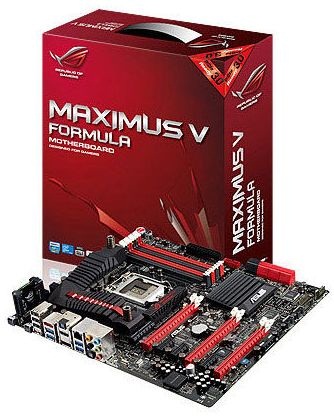ASUS Maximus V Formula Z77 ROG Review
by Ian Cutress on March 25, 2013 2:30 PM EST- Posted in
- Motherboards
- Asus
- ROG
- Z77
Final Words
When I published my review of the ASRock Z77 OC Formula, I praised it as the best board ASRock have ever made. I gave it a Silver Award due to its ease of use, the styling, the level of equipment, and the price which left me feeling all warm and fuzzy inside. Within days of the review being published, ASUS gave me a call. At this time, they were the only manufacturer out of the top four that had not committed any motherboard to my Z77 OC motherboard roundup (Z77 OC Formula, Z77 MPower, Z77X-UP7). So when I gave the ASRock Z77 OC Formula a Silver Award, they quickly wanted to point out just how good the Maximus V Formula was in comparison, and got around to sending me one for review.
As part of this review, ASUS was also keen for me to experience the features of the Maximus V Formula. Our good friend Rajinder Gill, now an audio engineer with ASUS, visited me with several sets of headphones from £70 to £1000 to experience the SupremeFX IV audio system on the Formula, as well as discuss the features on the range. Being no stranger to motherboard flaws and design, Rajinder and I talked at length about the pros and cons of the motherboard industry, motherboard audio, feeling, options, settings, BIOS versions, and how a review should be felt and written, not just a bunch of synthetic tests with a score and a [insert random award] type scenario. For reference on the audio (I cite my comment in the review about the fact that I will always admit to being tone deaf and singing karaoke like a deaf horse with a throat infection), using the high quality headphones with SupremeFX IV and the headphone amplifier makes a distinct difference to the richness of the audio. I rather unsurprisingly felt the biggest difference using a $2 set of headphones in the front audio connectors of the MVF vs. a regular ALC898.
As for the MVF as a package, we have a lot of good points to consider. The MVF is a well built product that performs well but also overclocked like a beast on our setup, both for processor and memory. It hits the high notes in the benchmarks for both performance and efficiency. In the package we get built in WiFi, an Intel NIC, a total of 10 SATA ports, a combination air/water VRM cooler for enthusiasts, the best ALC898-based audio package on a motherboard to date, and not to forget all the fan headers.
The BIOS and software package from ASUS has always been one of the best in our current generation of products, and the ROG feel puts an extra gloss on everything that you use. Extreme overclockers will find the multitude of options that they want here, as well as cooling enthusiasts that must have control over all their fans (and software that actually understands how fans work!).

There are some areas ASUS can improve on where the competition are perhaps getting a minor but noticeable lead. ASRock may not have an EZ mode BIOS, but the Z77 OC Formula offers more automatic overclock options, as well as a better experience due to the enhanced visuals. ASRock also include some plastic standoffs in the package for overclockers to quickly set up a motherboard rather than resting it on a box. Gigabyte has Gigabyte TweakLauncher, a simple GUI overclocking tool for every setting that can be changed in an instant. Both ASRock and Gigabyte have two BIOSes on board in case something goes wrong, and ASRock + MSI have easier to use voltage read points. I also prefer MSI’s method of more VGA power via a 6-pin PCIe connector rather than the 4-pin molex. Gigabyte also includes the OC Touch buttons, which are great for those extra few MHz.
Price wise, the MVF is $290 with AC3 with the package, but has been $270-$300 without in the past eight weeks. Compared to the ASRock Z77 OC Formula ($240, $225 on promo), MSI Z77 MPower ($210, $190 on promo) and the Gigabyte Z77X-UP7 ($400), the Maximus V Formula from ASUS does come along as the most expensive Z77 motherboard without a PLX 8747 chip.
The main competition is from the ASRock Z77 OC Formula of course, which can be $30-$75 cheaper depending on the sales. The ASUS does offer that little bit more – audio, performance at stock/efficiency, software, memory overclocking. The ASUS is definitely more the gamers’ motherboard than the ASRock, which was built more for overclocking - as such the ASRock gives easier voltage read points, more automatic OC options and two BIOSes. As a gamer, I would choose the ASUS due to the software package and the audio capabilities. As a casual competitive overclocker, it is a tough call – I personally had an easier experience with the ASRock, and it would be cheaper to replace if I thrashed and broke it, but I achieved more with the ASUS when pushing the limit. If I am going after scores where I need to be on that limit, the ASUS is the weapon of choice.
The ROG brand from ASUS always produces motherboards worth having. Giving the Formula the SupremeFX IV over the Gene and Extreme puts it into a SKU class of its own which it needed. On the basis of previous reviews, it is hard not to give the Maximus V Formula from ASUS anything but a Silver Award:

ASUS Maximus V Formula
Editor’s Choice Silver Award
The ASUS Maximus V Formula competes in a tough arena with rivals armed to the teeth, and comes out the other side with everything intact ready to fight another day. The competition doesn’t get tougher than this.










38 Comments
View All Comments
UzairH - Tuesday, March 26, 2013 - link
When I researched the effects of x8 vs x16, some games did have tangible framerates hits. I also understand there is some latency from the PLX chip, so the question is: does the MVF utilize the PLX when two graphics cards are deployed, or only when 3 are in use?IanCutress - Tuesday, March 26, 2013 - link
The PLX chip on the MVF works with IO as it is a PCIe 2.0 switch. It is not the PLX8747 commonly used to dissect PCIe 3.0 lanes for GPUs.UzairH - Tuesday, March 26, 2013 - link
Thanks for clearing that up Ian :) I take it then that there is NO latency from the PLX chip since it doesn't do anything with the PCIe slots.Overall, I am trying to decide between this board or the ASRock Z77 OC Formula. Ian, which of these two would you use yourself in a gaming build with GTX 670 SLI and a standard overclocked (4.2~4.4 GHz) 3570k? One important value-add is of course the "SupremeFX IV" audio solution on the MVF - I was considering getting one of Asus' Xonar cards for sound, how would you say the SupremeFX IV compares to the DX or Essence STX when paired with good headphones?
hurrakan - Tuesday, March 26, 2013 - link
I wish they would stop using the Intel 82579V NIC, or at least fix it - it's been horrendously broken for years. Search Google for "82579v" and you'll see.It constantly disconnects every minute unless you force it to 100Mbps. I wish I had bought a motherboard with dual LAN. And I'm going to make sure my next motherboard does not have Intel 82579V!
vailr - Tuesday, March 26, 2013 - link
The Intel 82579V NIC has performed fawlessly on my Gigabyte Z77-UD5H board.Maybe your board's NIC has a defect?
hurrakan - Sunday, April 14, 2013 - link
It was fine for a few months, then started disconnecting and reconnecting every 2 minutes - extremely annoying and made playing MMOs impossible. Now it only works by forcing to 100MBps instead of 1GBps.Apparently a very common problem - there's a 13 page thread on Intel community forums.
I saw one place suggest it is caused by the Gigabit Ethernet region of the motherboard BIOS getting corrupted.
Sabresiberian - Tuesday, April 2, 2013 - link
I would rather they add a PLX chip than spend the money on beefing up the audio capabilities of the mainboard. I mean, they did a good job as far as they went, but its still not as good as, say, one of their own Xonar solutions, which is what I'm going to use anyway. To me, either you care about better sound and you are going to spend a little money to get it, or you're happy with what comes on mainboards and so aren't; an in-between solution is a solution for a kind of person that I don't think really exists.Nivin - Thursday, May 2, 2013 - link
Just wondering. Does this motherboard come with a liquid cooling system of its own or is it just optimized for one. I am planning to buy this for my gaming pc but i also am going to buy a Cooler Master Seidon 240m if the motherboard doesnt have its own liquid cooling system. Also, if it does come with a LCS, is it good compared to getting one yourself.Thanks, Nivin